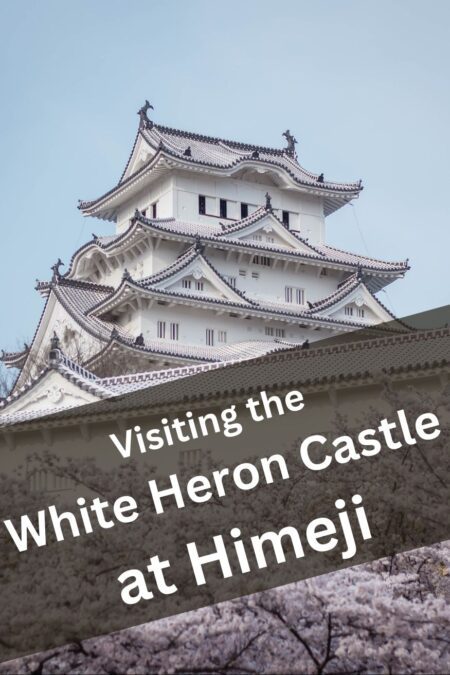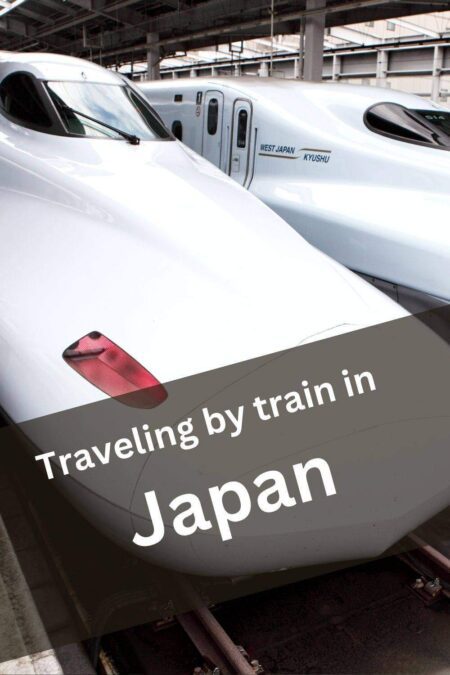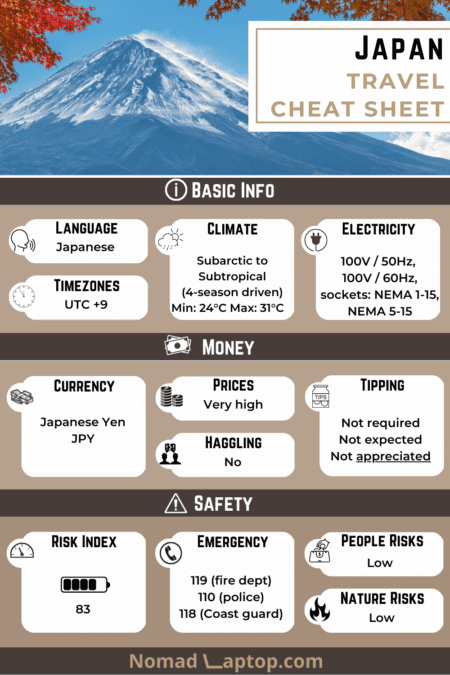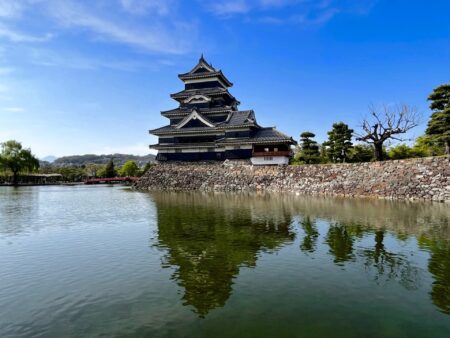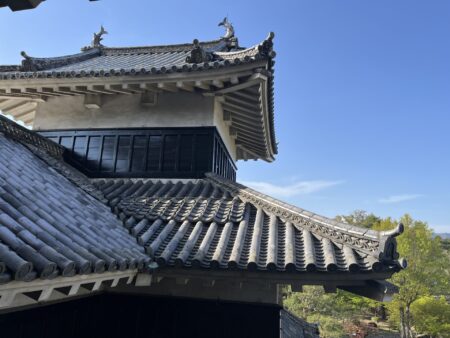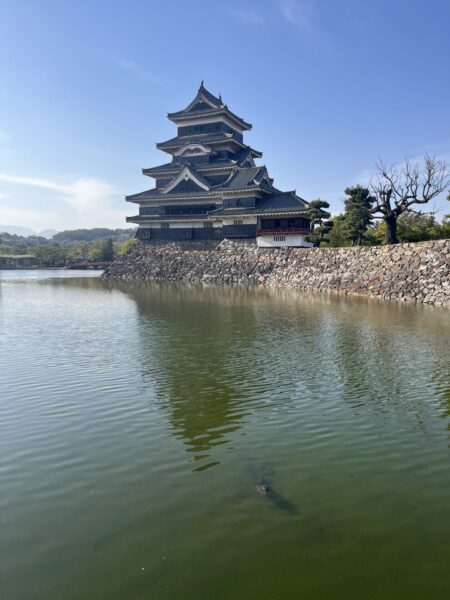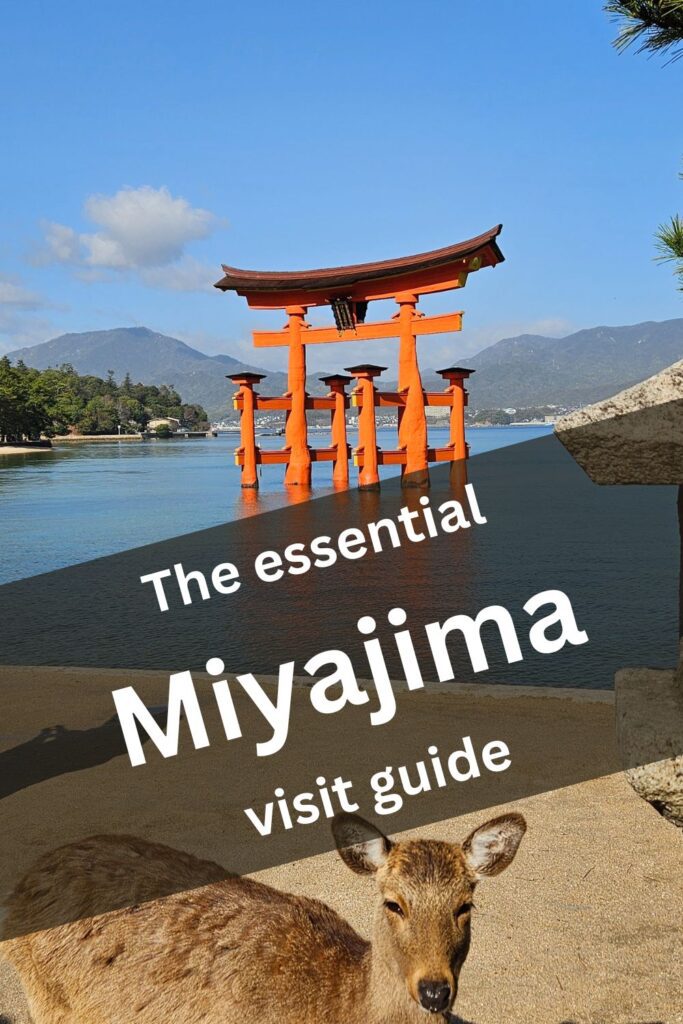Matsumoto (松本) is the second-largest city in Nagano Prefecture. It is popular among mountain lovers for its proximity to the Northern Japanese Alps and is also renowned for its locals, who are known for being some of the most outgoing and friendly people in all of Japan.
A visit to Matsumoto is a great addition to a trip to Japan, as the simple traditional life found, for example, on Nakamachi Street, where traditional stores and preserved buildings can be found, takes its visitors back in time.
The most famous attraction in the city is its castle, Matsumotojō (松本城), one of Japan’s most beautiful original castles.
Dating back to 1590, its dark black wood exterior gave it the name “the Black Crow” castle. It is a popular spot during cherry blossom season, and the surrounding Japanese Alps are sure to inspire any visitors.
Here you can find some information and tips on how to best visit this astonishing architectural marvel.
Yin and Yang. After this Black Crow Castle be sure to check out the article on the more famous and mesmerizing White Heron Castle of Himeji.
Basic info
Matsumoto Castle, originally known as Fukashi Castle is one of the three premier castles of Japan, along with Himeji and Kumamoto.
The atmosphere surrounding the castle is beautiful and calm, with koi fish peacefully swimming in the moat, and the Japanese Alps dotted in the background. In the evenings the castle is illuminated creating a beautiful scene that can be seen from the surrounding park.
About
Matsumotojō was built between 1592 and 1614 during the tumultuous Sengoku period, also known as the Warring States Period, and was continuously in use until the Edo period, when it was the seat of the Matsumoto domain in the Tokugawa shogunate, until the Meiji restoration of 1868.
After the consolidation of the Tokugawa shogunate, which unified Japan and brought relative peace, a third tower was built in 1635, which was barely defended, as well as a “Moon Viewing” pavilion in the main keep, which is also a defenseless platform.
The interior of Matsumoto Castle is wooden, with steep stairs meant to slow down the advance of potential invaders and small eyelets in place of windows. All this provides an interesting glimpse into ancient times, as opposed to other castles that have been rebuilt with concrete and steel.
Matsumoto Castle is also a popular cherry blossom spot, as the castle grounds and the park surrounding the moat contain hundreds of somei yoshino cherry trees.
In addition to the well-known samurais and resident samurai, Matsumoto was also a castle that was served by ninjas from the Akutagawa family starting around the 1600s. Today, around the castle grounds, re-enactors of ninja traditions and secret arts can be found performing.
Getting there
As always, the easiest way to reach Matsumoto is using the stellar Japanese train network.
From Nagano, the Shinano JR limited express to Matsumoto takes about 1 hour and is covered by the Japan Rail Pass which most foreign visitors often get.
Nagano itself is also easy to reach. From Tokyo, the Hokuriku Shinkansen to Nagano takes around 80 minutes. The closest large city in the north is Toyama, and from there, the Hokuriku Shinkansen line will take you to Nagano in around 50 minutes.
Once you arrive at Matsumoto Central Station, the castle is about a 15-minute walk away.
For more information on traveling by train in Japan, check out this article
Japan Info & Stats
- Language: Japanese
- Timezone: UTC +9
- Political System: Parliamentary constitutional monarchy
- Ethic Groups: Japanese 98.5%, Koreans 0.5%, Chinese 0.4%, other 0.6%
- Religions: Shinto 48.6%, Buddhist 46.3%, 1% Christian, 4% other
- Credit Cards: Credit cards are widely accepted
- Electricity: 100 volt / 50 hertz and 100 volt / 60 hertz (NEMA 1-15, NEMA 5-15)
- Haggling Culture: Not common
Prices
Tickets to visit Matsumoto Castle are priced at ¥700.
Best time to visit
Season
The most popular season to visit is spring, but every season has it’s own charm. See the section below on the weather in the different seasons of Japan.
Opening hours
The castle is open all week from Monday to Sunday and from 08:30 a.m. – 05:00 p.m. Admission ends 30 minutes before closing time. It remains closed on 29 and 30 December.
Trivia pill
Beware of Golden Week in Japan between April 29 and May 5th, and if visiting, be sure to book tickets, restaurant reservations, and hotels well in advance. That week contains a series of four national holidays and is a time of vacation for the Japanese people, many of which visit the most popular spots in their country.
As such, there are a lot of crowds, and queues can be long. Additionally, accommodations are often fully booked, and finding a place in restaurants without a prior reservation can also be quite hard. Restaurants in particular are already a bit “harsh” on foreign tourists and often will not accept them for various reasons, and this is especially true during Golden Week.
Entrances & Getting around
Being a defensive castle, there is only one entrance to the castle grounds across a bridge traversing the surrounding moat.
Once inside, there is a very large open field, which is where the main Honmaru building used to stand. It was destroyed by a fire, leaving only the current Ninomaru portion, and the space previously occupied by the Honmaru is known today as the Ninomaru Garden.
The Castle and grounds
Contrary to many other castles that were built on hilltops for better defense, Matsumotojo is a hirajiro, meaning a castle built on a plain.
The castle was initially built as a fortress. As such, there are few windows instead replaced by small eyelets. The castle is also a six-story building but externally appears as a five-story building, as one of the floors is hidden and was meant to hide supplies and confuse attackers. Stairs are incredibly steep, another defensive mechanism to slow down invading forces.
As stated earlier, after the end of the Warring States Period, the castle underwent additions intended to cater more to the enjoyment of the resident daimyo (feudal lord) than defense purposes. The most notable of these is the Moon Viewing Pavilion, which offers great views of the surrounding castle grounds, the city of Matsumoto, and the Japanese Alps.
Guides & tours
As in other historical castles, there are English-speaking volunteer guides standing at the castle entrance.
Alternatively, licensed guides from the NIGN (Nagano Interpreter Guide Net) can be booked in advance here, or you can check out the offers below.
Offers for Matsumoto
Weather
Japan is proud of it’s varied and distinct seasons, and Matsumoto is no different. As such, winters are cold and summers are extremely hot and humid. As elsewhere in the country, the best visiting seasons are autumn and spring, especially because of the colors of the leaves in fall and the flowers in spring. The temperature is also much more forgiving, being warm but not too hot.
Matsumoto is also a popular spot for Hanami (cherry blossom viewing) in the spring.
Clothing/Gear
Matsumoto is a popular place for reaching the Japanese Alps, where hiking gear is clearly recommended. Visiting the city itself and the castle, though, does not require any particular gear. As with other castles and buildings in the country, shoes must be removed upon entrance, so wear decent socks.
